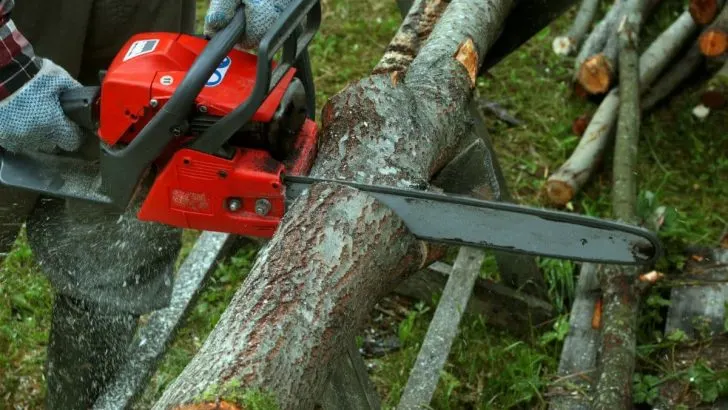When using a chainsaw, excessive smoking or burn marks on your wood isn’t ideal and can indicate a number of things. Additionally, if you notice that it has become more challenging to get the blade of your chainsaw through the wood you’re cutting, something is likely wrong.
A chainsaw might be burning the wood if the chain is dull or rusty. Burning is also caused by a lack of lubrication or chains that are damaged and need replacing.
If you have noticed smoke or burning while cutting with your battery-powered or gas chainsaw, the saw is likely not functioning correctly. An improperly functioning chainsaw is inefficient and can even prove dangerous to use.
4 Reasons Your Chainsaw Burns Wood
Your chainsaw should effortlessly glide through wood, producing little to no smoke, no burning, and no fine sawdust. Burning wood while using your chainsaw may be caused by one of the following reasons:
- The chain is too dull.
- Rust has formed on the chain or bar.
- You need to lubricate your chainsaw.
- It’s time to replace your chain.
Luckily, none of these issues should require you to go out and purchase a brand-new chainsaw. In most cases, you can fix the core issue yourself. The rest of this article will teach you how to remedy issues that cause the wood to burn.
The Chain Is Too Dull
Chainsaw chains need to be sharpened regularly. Dull chains will cause your saw to catch as it cuts through wood and can put you at risk for serious injury. Your chains may have become dull for several reasons:
- Expected wear and tear.
- Placing too much pressure when sawing.
- Contact between the chains and the ground or dirt.
The friction the chainsaw’s blades apply to the wood always causes heat. With well-sharpened chains, the saw moves through the wood fast enough that the wood doesn’t have a chance to burn. With dull chains, it takes more pressure and time for the blades to get through, giving the wood the opportunity to burn (source).
How To Keep Your Chainsaw Blades Sharp
You can visually inspect your chainsaw and detect dullness. Superfine sawdust being produced while cutting can also indicate dull chains. Additionally, your chains may be too dull if the blades catch or otherwise travel through the wood in any way that doesn’t feel smooth and easy.
Keep your chainsaw in good condition by always storing it inside. A shed, garage, or even inside the bed of your truck are all better options than leaving it outside. Never leave your chainsaw outside in the elements.
Another way to maintain your chainsaw and extend the life of your chains is to clean it after each use. Debris can accumulate each time you use the saw, and this debris will build up behind the clutch cover. Cleaning your chainsaw after each use will keep everything in good working order (source).
The Chain Has Become Rusty
A rusty chain has a similar effect as a dull chain. Cutting through a log or other wooden object should feel smooth and efficient. If the chains are catching, producing fine sawdust, or burning the wood, you should inspect the chain and bar for rust. If you see any rust forming on the metal, you can clean it using the tips below.
How To Remove Rust From Your Chainsaw’s Chain
Rust is more likely to accumulate on a chainsaw that is rarely used. Here is a guide explaining how to clean rust from your chainsaw in four easy steps:
- Choose your cleaning agent. You can use a traditional solution like Rust-Oleum Rust Dissolver Gel (link to Amazon) to clean the rust off your chainsaw. This one quickly removes rust and helps to protect it for up to a year. Other solutions include pure white vinegar or even salt and lime. Choosing a rust-cleaning solution depends on your budget and resources.
- Apply the rust solution. If using a spray-on rust dissolver, follow the instructions on the packaging. To use vinegar, you can simply place the chains in a bucket filled with vinegar and leave it for 2 to 3 hours. If you’ve decided to use salt and lime, sprinkle both onto the surface of your bar and chains. Let the mixture sit for a few hours before carefully scrubbing the rust away.
- Rinse and dry your chainsaw. Thoroughly rinse and wipe down the chainsaw’s bar and chains with water. Once the cleaning solution has been rinsed away, dry both as completely as you can using regular shop towels or these AmazonBasics Microfiber Cleaning Cloths (link to Amazon). These are non-abrasive and machine-washable, making them easy to clean and reuse.
- Reassemble your chainsaw. Now that the rust has been scrubbed away and your chainsaw is clean and shining, it’s time to reassemble the chainsaw. Do so carefully to avoid cutting yourself, and always remove the battery or clean the saw when it is out of fuel, so you don’t accidentally switch it on (source).
You Need To Lubricate Your Chainsaw
A poorly-lubricated chainsaw will cause the wood to burn while you saw through it. Get into the habit of checking your chainsaw’s bar and chain oil each time you refuel. If the chains need to be lubricated, you will need to purchase bar and chain oil to fix the problem. Regular motor oil is not adequate for a chainsaw (source).
How To Lubricate a Chainsaw
You can lubricate your chainsaw in 5 easy steps:
- Remove the battery or drain the fuel before you start working as a safety precaution.
- Disassemble the chainsaw by removing the bar and chain, and take this opportunity to clean debris from behind the clutch cover.
- Place the chain in a gallon-sized (3.78-liter) plastic bag and add a small amount of bar and chain oil before letting the bag sit for as long as possible, ideally overnight.
- Wipe the excess oil from the chain after removing it from the bag.
- Reassemble your chainsaw and test the chain manually to ensure proper tension before reinserting the battery or adding fuel.
To help you better understand, here’s a YouTube video that demonstrates the process:
It’s Time To Replace the Chain
As with any good tool, sometimes you need to perform maintenance on your chainsaw. This includes knowing when it’s time to replace your chain. If the wood is still burning after you’ve tried all the above fixes, it may be time to get a new chain.
Another way to tell if your chain needs to be replaced is by inspecting the teeth. If the teeth are broken, you must replace the chain. Broken teeth cannot be sharpened and will not perform efficiently. Your chain’s teeth can become broken after coming in contact with rocks, dirt, or other non-wood materials (source).
Conclusion
When you notice burning or smoking when cutting through wood with a chainsaw, you should check for the following:
- Chain dullness.
- Rusty chains.
- Poor lubrication or low bar and chain oil.
- Broken teeth.
Now you know how to detect problems that cause a chainsaw to burn the wood, and you can keep up with the maintenance of your saw to avoid this problem, extend the life of your saw and its chains, and ensure your safety during your next wood-cutting project.
Does your chainsaw engine smell? Read my guide to learn more about the reasons and ways to fix the issues.

